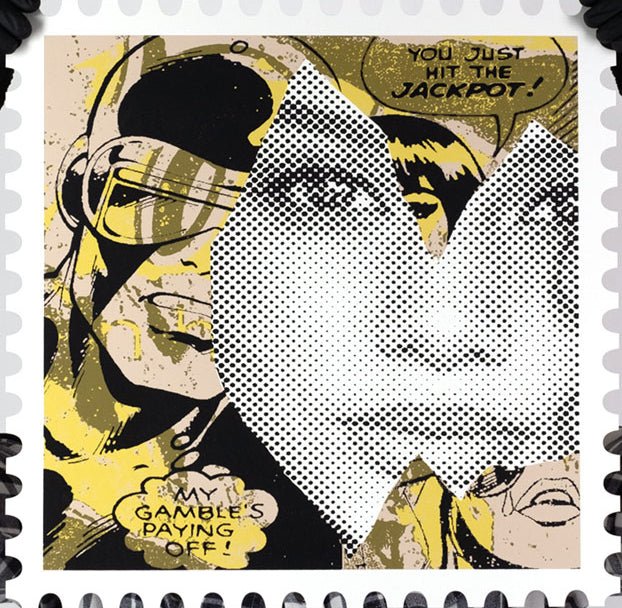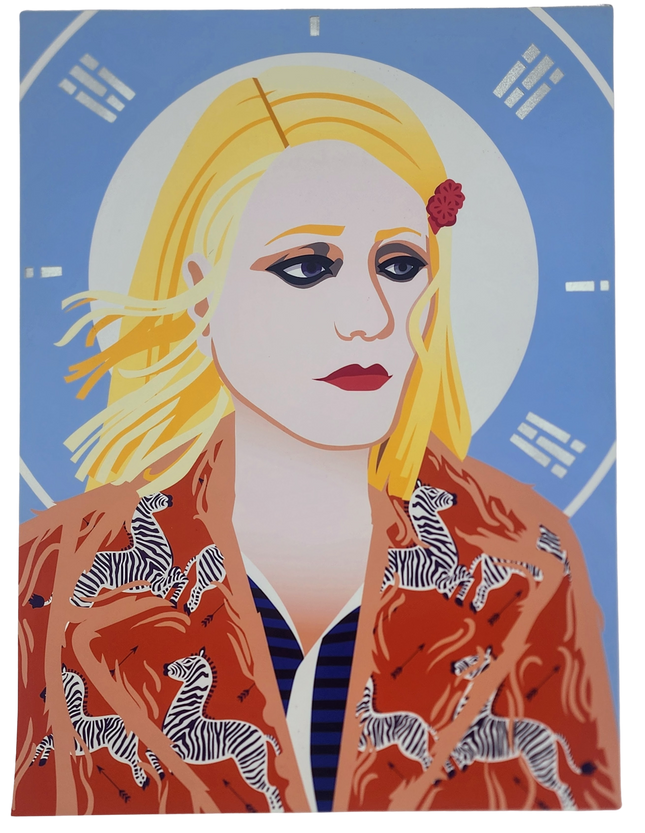
Die Cut Art

Marly Mcfly Jackpot Yellow Silkscreen Print by Marly Mcfly
Jackpot- Yellow Limited Edition 4-Color Hand-Pulled Silkscreen Print on Die-Cut 290gsm Coventry Rag Fine Art Paper by Marly Mcfly Graffiti Street Artist Modern Pop Art. 2021 Signed & Numbered Limited Edition of 25 Artwork Size 16x16 I am a self-taught artist from Newport News, VA. I began to pursue art as a child drawing everything from cartoons, comics, action figures and athletes. My inner thoughts and my experiences are captured through layers of bright bold colors and patterns coupled with images from my childhood which are utilized to express myself.
$382.00

Kevin Stanton Margot Silver Hand Cut HPM Giclee Print by Kevin Stanton
Margot Silver Hand Cut HPM Spray Paint Giclee Print by Kevin Stanton Artwork Limited Edition Print on Layered Glitter Fine Art Paper Hand Embellished Print Graffiti Pop Street Artist. 2013 Signed & Numbered Spray Paint Glitter Paper Hand Cut Embellished Limited Edition #1 of 4 Artwork Size 11.75x15.75 HPM Giclee Print. Silver Paper Collage of the Woman Gwyneth Paltrow as Margot Tenenbaum Stylized from the Movie The Royal Tenenbaums. Kevin Stanton's "Margot Silver": An Ode to Cinematic Iconography The "Margot Silver" hand-cut HPM (hand-painted multiple) Giclee print is a masterful creation by Kevin Stanton, a renowned Graffiti Pop Street Art figure. This piece is exceptional as a limited edition work, being the first in a series of four, each meticulously signed and numbered by the artist. The artwork, sized 11.75x15.75 inches, is a silver paper collage on layered glitter fine art paper, which has been hand-embellished to enhance its visual appeal. Stanton's piece pays homage to Gwyneth Paltrow's character, Margot Tenenbaum, from Wes Anderson's critically acclaimed film "The Royal Tenenbaums." Interplay of Film and Street Art Aesthetics Stanton's "Margot Silver" is a prime example of how the realms of pop culture and street art can intertwine to produce work that is both referential and original. The piece takes a character made famous in cinema and reinterprets her through the lens of street art, employing techniques like spray paint, which are traditionally associated with graffiti. The result is a bold, graphic portrayal that captures the essence of Margot Tenenbaum's character through stylized form and color, resonating with the vibrancy and immediacy found in Street Pop Art. This print is more than a representation of a film character; it is a dialogue with the audience, inviting them to revisit the familiar in a new light. Just as street art often repurposes public spaces to create something that commands attention and sparks conversation, Stanton's work repurposes the image of a well-known figure, encouraging viewers to engage with the character and the art on a deeper level. Craftsmanship in Contemporary Art In "Margot Silver," the craftsmanship is evident in the precise cuts and the thoughtful application of embellishments, which bring the piece to life. Using glitter paper adds a textural dimension that contrasts with the flatness often associated with spray paint, demonstrating Stanton's skill in marrying disparate elements to create harmony on the canvas. The work reflects a broader movement in contemporary art that sees artists bringing traditional techniques into the conversation with modern themes and mediums. Stanton's approach to his craft, particularly the intricate cut-paper method, echoes the meticulousness of street artists who spend hours perfecting their murals and stencils. His limited edition print, much like a carefully curated mural, becomes a landmark in the landscape of contemporary art—a marker of creativity and ingenuity. The Lasting Impact of "Margot Silver" Kevin Stanton's "Margot Silver" symbolizes the artist's dedication to pushing the boundaries of street-inspired art. By choosing to immortalize a cinematic character through the methods and mediums of street art, Stanton not only pays tribute to the character and the power of visual storytelling. His work stands as a reminder that the essence of street pop art and graffiti art lies in its ability to transform the familiar into something extraordinary, to imbue the everyday with significance and beauty. The print remains a captivating piece within Stanton's oeuvre, a testament to his ability to navigate and transcend the realms of street and pop art. As the art world continues to evolve, works like "Margot Silver" prove the enduring spirit of innovation that drives artists like Kevin Stanton to create pieces that are both of the moment and timeless.
$175.00



